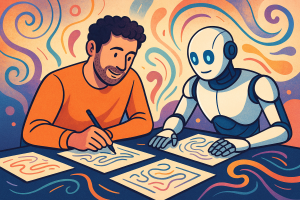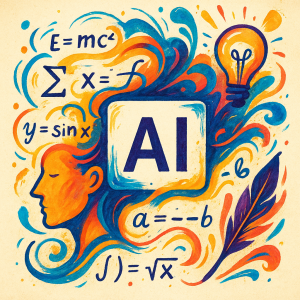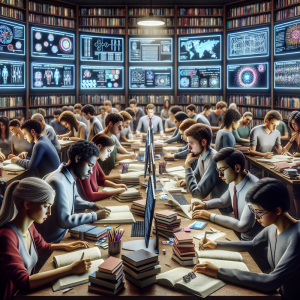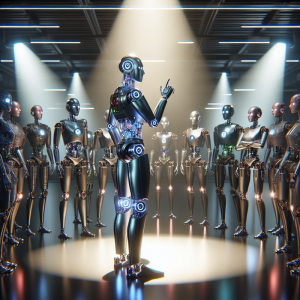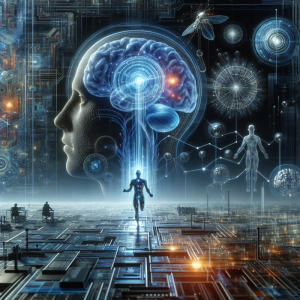The Limits of Linear Thinking
Most of us were trained to think in straight lines. Problem → Solution. Input → Output. Cause → Effect. That’s how school works, that’s how business hierarchies work, and that’s how most “subject matter experts” get their edge. Vertical depth, built on decades of digging into a single lane.
But here’s the thing: AI doesn’t think in straight lines. It doesn’t stay in lanes. It pulls from every source it can reach, connects dots across domains, and surfaces patterns that don’t fit neatly into a hierarchy. Trying to make sense of the output is a staggering leap for most people.
That’s why if we insist on thinking linearly, we’re working against how AI actually constructs logic. It’s like trying to run Windows software on a Mac—you can force it, but it’s clunky and it misses the point. It’s like almond flour in those Paleo “Cookies”. Just because something has chocolate chips in it, doesn’t mean it’s a “cookie”. But I digress…
How AI Thinks: Fast, Parallel, and Non-Linear
AI systems collect data horizontally, not vertically. More accurately, it collects in almost a 360 degree vantage point. They don’t stop and ask, “Is this in my subject domain?” They just eat it all—finance reports, medical journals, TikTok captions, and the like, and look for correlations.
-
Parallel processing: An AI model can test thousands of connections simultaneously. Humans? We do one or two at a time, maybe three if we’re wired on espresso. And there are a TON of studies that definitively proves we are wholly unable to run parallel tasks, only serial.
-
Pattern-matching at scale: Where a human sees two unrelated industries, AI might spot a structural similarity—say, how hospital bed shortages resemble logistics bottlenecks.
-
Non-linear leaps: It can skip rungs on the ladder. Where vertical experts climb carefully step by step, AI jumps not only up and down but also side-to-side to other ladders.
This doesn’t mean AI is “smarter” than us, it just thinks differently than we do (not that think differently). And if we want to use it effectively, we have to learn to think differently too.
Why Vertical Thinking Falls Short
Vertical thinking is the lever most experts pull because it’s comfortable. Depth feels safe. “I know this subject inside and out, so I must be right.” It is also subject to a boatload of human-centric biases. Not that AI removes all of those but it is certainly better than we are at stripping them back. Moreover, we can prompt out a particular bias if we do it right. You can’t do that with your brother-in-law who insists he is right when you know he is not.
But AI doesn’t care about your subject boundaries. It doesn’t stop at what’s inside the textbook. It makes connections across physics and finance, medicine and marketing, history and machine learning. It is all on the table. Ever seen the Matrix? Yeah, that. I know Kung Fu…
If your thinking is trapped in one vertical, you’ll miss the insights AI is surfacing horizontally. You’ll reject patterns that don’t fit your worldview. You’ll assume the answer “can’t be right” because it didn’t come from your lane of expertise. Worse, the now-old-news refrain of “well AI was great for writing my email (glossing over the fact they didn’t pay a copywriter) but I am not sure I would fully trust it to do my will (oh and this person happens to be a lawyer).
That’s not just limiting—it’s counterproductive.
What Horizontal Thinking Looks Like
So what does it mean to think horizontally, especially in an AI-driven world?
-
Cross-pollination: Borrowing frameworks from one field to solve problems in another. Example: applying epidemiology models to cybersecurity risk.
-
Lateral parallels: Seeing how one pattern recurs across industries. Example: recognizing that social networks and supply chains both depend on hub nodes and can fail at weak links.
-
Embracing non-linear logic: Accepting that the shortest path from A to B may zigzag through X, Y, and Z.
When you think this way, you’re not trying to out-AI the AI. You’re syncing your own thinking with its logic, amplifying what it does best.
Real-World Benefits of Horizontal Thinking
Here’s where it gets practical:
-
Better collaboration with AI tools: Instead of feeding a model siloed data, you bring it richer inputs that span domains, which makes outputs more surprising and useful.
-
Stronger innovation pipelines: Breakthroughs often come from crossing disciplines. Horizontal thinkers see opportunities where vertical experts see walls.
-
More adaptive strategy: Businesses that orient horizontally can pivot faster, because they’re not locked into one rigid worldview.
For our clients, this isn’t theory, it’s practice. We’ve worked with enterprises that initially approached AI like a linear upgrade to their existing processes. Once they re-oriented horizontally, their ability to see patterns across departments, industries, and even cultural shifts exploded.
Short-Term Wins vs. Long-Term Evolution
Short-term (1–3 years): Teams that adopt horizontal thinking now will get more value out of existing AI systems. They’ll stop fighting the tools and start harnessing them. Even simple things like pulling insights across marketing + operations instead of treating them separately pay off quickly.
Long-term (5–10+ years): The organizations that embrace horizontal thinking will set themselves up for something bigger: co-creating with AI. Because the systems of the future won’t just answer questions in one domain. They’ll reframe problems across all relevant domains. If you’re stuck in linear depth, you’ll get left behind. This comes down to a mix of willingness to explore a wider frame of view as well as the knowledge to know when to go where. It truly is a new set of skills we have not had the need for or access to until now.
The Challenge of Changing Minds
Of course, none of this is easy. A few hurdles:
-
Experts love vertical lanes. It’s what their careers are built on. Asking them to think horizontally feels like pulling the floor out from under them. It also taps a core human emotion, fear. People, for better or worse, like their jet skis and new cars. A lot. Threatening their jobs threatens all of that. Brick wall number one.
-
Non-linear feels wrong. Human brains crave order and sequence. When AI jumps across fields, our instinct is to distrust it. This isn’t their fault per se. Parents teach us this from early childhood. School beats this into us just after that. College cements this fallacy once and for all. By the time we hit adulthood most of us have lost all imagination to the point that any imagination feels dirty. “Something hippies do”. Brick wall number two.
-
Horizontal ≠ shallow. Some fear that going wide means losing depth. The trick is balance. Breadth is informed by depth, it does not replace it. This is the hardest part in my opinion as I was born to think this way. Not everyone was. We live in an age where taking a vacation day feels like a cardinal sin. We are barely out of the age where people bragged about how much they didn’t use. Through that lens, it isn’t hard to see why this is a really, really challenging bring wall number three.
These are cultural and cognitive shifts, not just technical ones. We have done this to ourselves by accident and un-doing this will take work.
And that is where we come in.
Why This Shift Matters Now
Here’s why I’m bullish on this: thinking horizontally isn’t optional anymore.
AI isn’t going back to linear logic. It’s not going to slow down or wait for us to catch up. The only move is to adapt and to rewire how we frame problems so we can get the most out of this technology.
And the good news? Once you start thinking this way, it’s addictive. You begin to see patterns everywhere. You stop asking, “What does my lane say about this?” and start asking, “What does the whole system reveal?”
That’s where breakthroughs live. That’s how we evolve with AI instead of getting steamrolled by it.


